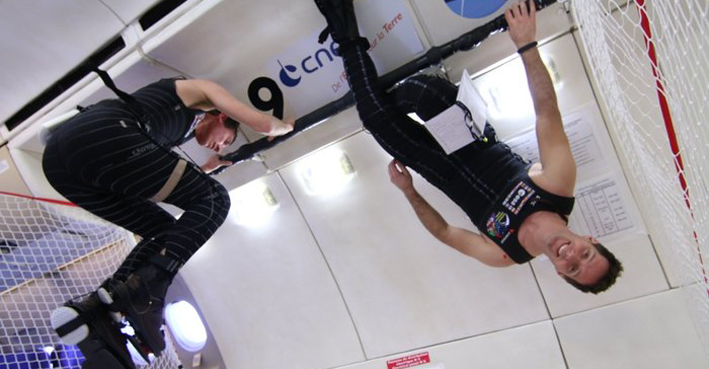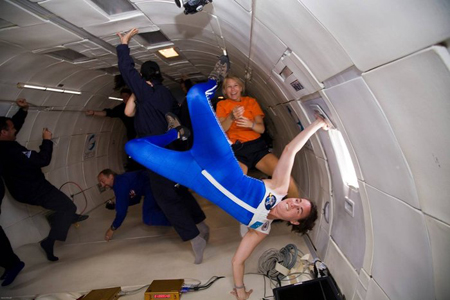A Space Suit that Squeezes
By Vinita Marwaha Madill
A new space suit design uses advanced materials to combat muscle and bone loss for astronauts in outer space.
August 18, 2015
The Long View Technology
Editor’s Note: In the September—October 2015 issue of American Scientist, engineer David P. Cadogan detailed the development of American space suits. Here, engineer Vinita Marwaha Madill fills out that story with some advances in suit design coming from the European Space Agency.
Why haven’t humans landed on Mars yet? Many people throughout the world have asked this question. Have we yet to set foot on the proverbial red planet because the current state of technology to carry out such a mission is lacking, or because of the danger of radiation exposure for the crew during the journey? Although these concerns are limiting factors, one of the most formidable barriers to overcome for human deep-space exploration is that of the human body itself. The simple fact is that the human body has evolved in the presence of Earth’s gravity. Without this force, astronauts currently lose 1 to 2 percent of their bone mass per month on the International Space Station (ISS), particularly from crucial weight-bearing spine and lower limb bones. This rate of loss is 10 to 15 times faster than that of the most serious osteoporosis patient on Earth. The lack of gravity and decrease in muscle use also causes muscle atrophy, with one astronaut losing 54 percent of his single leg power after spending 21 days in space on the Skylab mission. A journey to Mars would take an average of 260 days, ample time for crippling bone and muscle loss.

CNES/Novespace.
To partially mitigate such debilitating effects of spaceflight, astronauts currently exercise for 2.5 hours each day on the ISS, enough to maintain their bone and muscle strength. But new technology may soon help their plight. The European Space Agency (ESA) is developing a space suit that could help an astronaut landing on Mars or living in space on a long-duration mission to remain relatively healthy. The Gravity Loading Countermeasure Skinsuit (GLCS) has the potential to provide a valuable countermeasure against bone loss by mimicking the effects of gravity. The suit will make its space debut in September as it’s launched to the ISS and worn by Danish ESA astronaut Andreas Mogensen. It has been designed by a consortium consisting of the Massachusetts Institute of Technology, Kings College London, University College London, and Wyle Laboratories GmbH.
The Skinsuit helps to solve an issue discovered almost 45 years ago during the Apollo 16 mission, as Lunar Module Pilot Charles Duke experienced difficulty putting on his spacesuit while preparing for his first walk on the Moon’s surface, five days after launch. He had grown 4 centimeters in the weightless environment, which had not been taken into account during his suit fittings. Today’s astronauts carrying out 6-month missions on the ISS can grow up to 5 to 7 centimeters in height, and this spinal growth causes tension in the vertebrae, and suffering back pain, for astronauts.
During my time at ESA, I worked with my engineering colleagues on the design of the Skinsuit to mitigate such problems, by replicating adequate mechanical loading on the skeleton and thus preventing the lengthening of the spine. With a force close to that felt on Earth, the suit effectively squeezes an astronaut’s body gradually in hundreds of stages from the shoulders to the feet. As an astronaut’s arms suffer negligible bone density loss in microgravity, the suit itself is sleeveless and supplies loading only to an astronaut’s torso and legs, with the load increasing from the shoulders downwards.

NASA–Waldie.
Along with positively affecting spine health, the suit could be used in conjunction with current exercise countermeasures on the ISS to help prevent bone loss. Bone also responds to loading, and the Skinsuit pressure on the skeleton stimulates bone growth. Research has shown that such mechanical loading causes bone to adapt its external shape and internal structures. This growth consequently decreases the risk of fracture if an astronaut is exposed to conditions of high skeletal strain, such as during an extravehicular activity (EVA, or space walk) or even a Mars mission, a situation that is particularly likely during liftoff or braking procedures for landing.
Skinsuits are tailor-made for each astronaut using a bidirectional elastic-weave material, creating high longitudinal but low circumferential material strain. This property allows the suit to be worn or donned with ease using a zipper while still providing mechanical pressurization for the entire body. The same technology could be used on Earth to prevent bone loss and muscle atrophy in coma patients and children with cystic fibrosis.
Although the Skinsuit is designed to be worn only inside a spacecraft, another, more experimental example of mechanical counterpressure suit for extravehicular use, which comes out of the same research, is MIT’s Biosuit. Designed to be worn during a mission to Mars, the Biosuit uses a shape-memory alloy material to create the necessary pressure on the astronaut’s skin, duplicating the pneumatic pressure of traditional NASA gas-pressurized EVA suits.
The effectiveness of the Skinsuit will be tested this year by astronaut Andreas Mogensen during his 10-day mission to the ISS, with measurements taken throughout to evaluate back pain and comfort, The suit will be used in conjunction with the exercise equipment on board the ISS. Depending on the results, the suit could be worn by British astronaut Tim Peake during his 6-month mission to the ISS later this year. After such test runs, future versions of the Skinsuit could potentially be used during a mission to Mars or on long-duration exploration missions to such destinations as an asteroid or L2, a region of gravitational stability 1 million miles from Earth.
The benefits that the suit provides, along with its light weight, makes it an ideal candidate to be used during such monumental missions. Humans have yet to explore the vast solar system beyond the Moon, but the international team working on this suit are providing one part of the solution to ensure humans will one day walk on the surface of Mars—and beyond.
American Scientist Comments and Discussion
To discuss our articles or comment on them, please share them and tag American Scientist on social media platforms. Here are links to our profiles on Twitter, Facebook, and LinkedIn.
If we re-share your post, we will moderate comments/discussion following our comments policy.